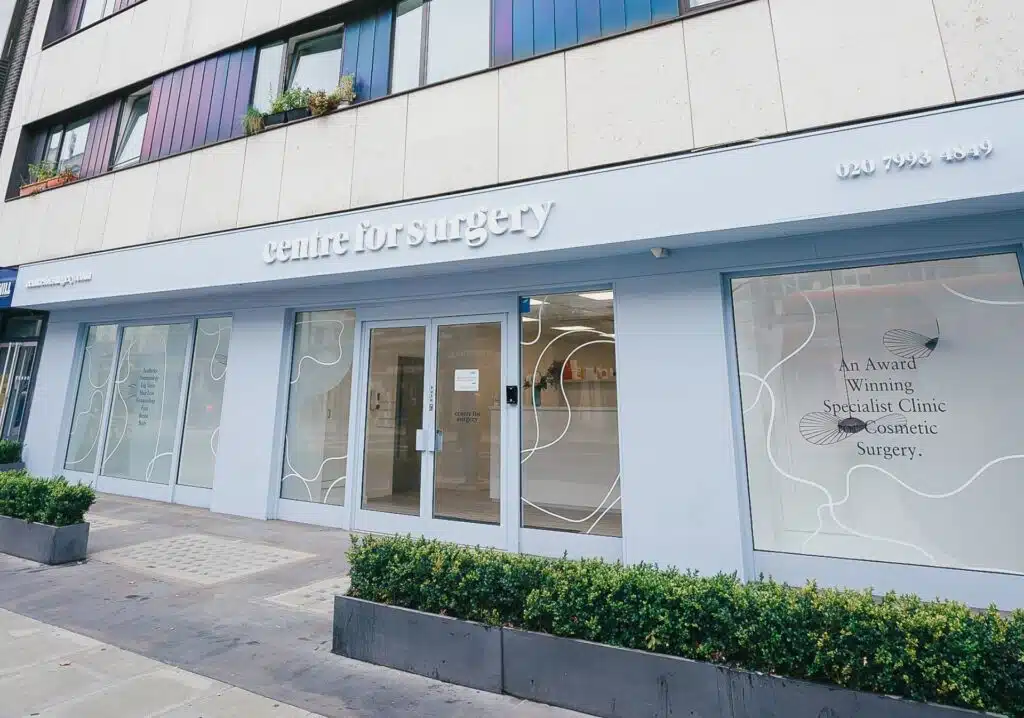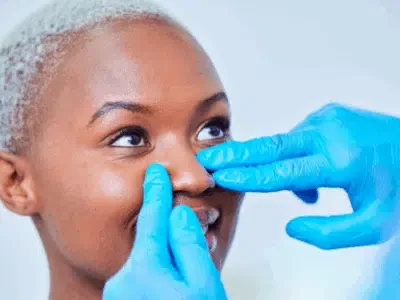The average recovery time for a primary rhinoplasty procedure varies between patients but is approximately 6 to 8 weeks. During this period, several activities should be avoided, including strenuous exercise and heavy lifting. Our postoperative nursing team will be able to advise you when it will be safe to start driving.
RELATED: Key Facts And Myths About Rhinoplasty Surgery
How long does rhinoplasty recovery take?
Rhinoplasty surgery is designed to alter the shape of the nose or correct structural deformities, whether present from birth or caused by traumatic injury, to improve the nose’s appearance. Rhinoplasty ranks as one of the most popular types of cosmetic surgery in the UK, and Centre for Surgery is one of the top London clinics for carrying out all types of nose job surgery. Many people think rhinoplasty recovery is often long and arduous. Here, we will dispel many myths about recovery after rhinoplasty by answering some of your most commonly asked questions.
RELATED: What does rhinoplasty recovery involve?
How long is the nose job recovery time?
Rhinoplasty is a highly specialist procedure performed by expert rhinoplasty surgeons. The procedure is most commonly performed under general anaesthetic and can take anywhere from one hour to 3 hours and beyond, depending on the complexity of the surgery. Once the procedure is complete, you will generally spend 3 to 4 hours recovering on our specialist day surgery recovery unit whilst being monitored by our highly trained recovery nurses. Once you are medically fit for discharge, you’re responsible adult escort will be given post-operative care instructions. Hence, they are comfortable and familiar with how to look after you for the first 24 hours after your rhinoplasty. We perform rhinoplasty as a day case procedure at Centre for Surgery in London, allowing you to recover in the comfort of your home later the same day.
RELATED: Nose Job Recovery Timeline – What to Expect
A typical rhinoplasty recovery time is generally between 6 to 8 weeks. Your surgeon will advise you to avoid certain activities for some or all of this period, including strenuous exercise, gym, and heavy lifting. You will be informed as to when it is safe to restart driving a car and sexual intercourse. Nose job surgery often results in temporary bruising around the lower eyelids and can appear swollen. Although it can look dramatic, these are temporary side effects and will quickly settle down. Any bruising under the eyes usually disappears within 7 to 10 days after the procedure. One week after surgery, you will be booked to see one of our postoperative nurses for a clinical review. The surgery site will be reviewed at this appointment, including checking the incision lines to ensure they appear healthy. We may often recommend several scar management strategies to minimise the appearance of scars, especially after open rhinoplasty.
We recommend sleeping with your head propped up on a couple of pillows for the first few days after surgery when you are resting at home, as this helps speed up your nose job recovery time by reducing localised swelling. It is essential to sleep on your back for a minimum of four weeks after having a rhinoplasty procedure to avoid distorting the nose during this early period of rhinoplasty healing.
RELATED: How to Sleep After Rhinoplasty
You should avoid picking your nose or blowing your nose, and if you feel the need to sneeze, you should try to do so through your mouth to prevent any undue pressure in the nose region. It would help if you also avoided particularly dusty environments with excessive amounts of smoke.
Getting the best rhinoplasty results depends on complying with all the postoperative care instructions given to you by your surgeon. Failing to follow the instructions in full may result in delayed healing and recovery after nose job surgery. All types of rhinoplasty require at least 12 months for complete healing and for swelling to settle down completely. In men, this can be up to 18 months for complete resolution of swelling. During this time, it is essential to remain patient, and your surgeon will be able to give advice on how to reduce swelling after rhinoplasty.
When is it safe to remove my nose splint?
Most types of rhinoplasty procedures, especially where bony work has been undertaken, such as removing a dorsal hump, will require the application of a postoperative splint to protect the healing nose. Rhinoplasty splints are made of several materials, including plaster of Paris, metal-backed aluminium splints or thermoplastic splints. The average duration for rhinoplasty splints to remain on is usually between 7 to 10 days, after which they will be removed by one of our postoperative nurses at your clinical review appointment. Some surgeons may require the splint to remain on for up to 14 days, especially after a revision rhinoplasty procedure.
The postoperative nurse will carefully remove your splint. At such an early time after rhinoplasty, it is very common for the nose to look very swollen and lack any definition of the tip. The tip will often look almost bulbous due to rhinoplasty swelling, which is entirely normal at such an early stage of healing. Swelling takes time to settle down, and the final rhinoplasty results can take between 6 to 12 months to appear. During the early period of rhinoplasty healing, you may notice the nose feels quite stiff, and the skin will require a period of time before it becomes soft and supple. The tip of the nose can often feel numb for the first 3 to 4 weeks after surgery, which is a normal finding.
When people suffer a fractured nose from traumatic injury, they often have to wear a similar type of nasal splint. Many patients are understandably reluctant for other people to know they have had cosmetic surgery. It would be reasonable for onlookers to assume you have had reconstructive surgery to explain why you have a rhinoplasty splint.
RELATED: Surgical versus non-surgical rhinoplasty
What things should I avoid during the nose job recovery period?
Ensuring a quick recovery after nose job surgery means refraining from several activities during the first 6 to 8 weeks after surgery. It is essential to keep moving after the surgery, even for gentle walks around the home during the first 3 to 4 days, to maintain blood flow in the legs and prevent the risk of venous thromboembolism. It would be best if you tried to avoid doing too much and should undoubtedly avoid vigorous activities, including going to the gym for a full six weeks. Most patients should avoid driving a car for at least two weeks after rhinoplasty. You should avoid sunlight exposure and use tanning beds, as this can increase the risk of developing hyperpigmentation of your scars, especially if you have had an open rhinoplasty. Sexual intercourse should be avoided until four weeks after the procedure. If you are unsure about a particular activity, please get in touch with our postoperative nursing team for further clarification to ensure your healing is as smooth and comfortable as possible. You should also avoid smoking, as this leads to delayed wound healing. A full rhinoplasty recovery takes, on average, between 6 to 8 weeks for most patients.
Is rhinoplasty painful?
Rhinoplasty is not a painful procedure, and any mild discomfort that patients may experience after surgery can be easily controlled with over-the-counter painkillers such as paracetamol. Common rhinoplasty side-effects in the early postoperative period are more often related to congestion and swelling and not pain. Nose reshaping surgery will usually result in a significant nose swelling, which means patients will have to breathe in their mouth for the first seven days. The nose may often feel stiff, and the tip of the nose may feel numb for the first few weeks. It is not uncommon to have significant bruising in the area of the lower eyelids, especially if the bone has been fractured during the procedure.
RELATED: Is Rhinoplasty Painful?
Your surgeon will apply an absorbent dressing to collect any tiny drops of blood for the first 24 hours after the procedure. It is highly unusual for significant bleeding to occur after the procedure. If you have had a septorhinoplasty, your surgeon may apply an internal nasal tampon to minimise the risk of bleeding.
In very rare cases, nose job surgery can result in several permanent complications, including injury to the delicate cartilage of the septum, breathing problems or a permanent alteration in the sense of smell. Heavy bleeding from the nose is highly unusual after rhinoplasty surgery. At your rhinoplasty consultation, your surgeon will explain the risks and complications of rhinoplasty surgery to allow you to make an informed decision on the nose-reshaping procedure.
Will Centre for Surgery provide ongoing support during my rhinoplasty recovery?
Centre for Surgery is a centre of excellence for rhinoplasty surgery, and we partner with some of the best rhinoplasty surgeons in the UK. Our surgeons specialise in all types of rhinoplasty surgery, including open and closed rhinoplasty, revision rhinoplasty, ultrasonic rhinoplasty and rhino-tip correction.
We are the leading cosmetic surgery clinic in London and are renowned for our exceptionally high postoperative care standards delivered by our specially trained postoperative nurses. During your rhinoplasty recovery period, you will be allocated your own dedicated nurse who will be able to answer any questions or concerns you may have 24/7. Once you have fully healed from your nose reshaping surgery, we have a specialist department to optimise the appearance of scars using the latest medical techniques.
If you would like to learn more about the benefits of rhinoplasty at Centre for Surgery, please call 020 7993 4849 to book an in-depth consultation with a specialist rhinoplasty surgeon in London.
RELATED: Non-Surgical Nose Reshaping: A Trend on the Rise










